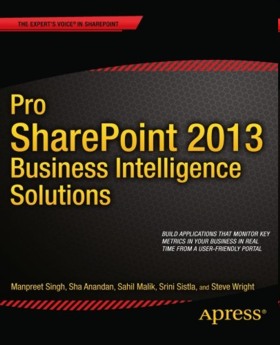Authors: Manpreet Singh, Sha Anandan, Sahil Malik, Srini Sistla & Steve Wright
Publisher: Apress, 2013
Pages: 440
ISBN: 978-1430258933
Aimed at: SharePoint administrators and developers
Rating: 4.5
Reviewed by: Kay Ewbank
This is a new edition of the popular title of similar name covering SharePoint 2010, updated to reflect the changes to SharePoint 2013.
Several of the authors are well-known speakers on SharePoint, and the style and strong content of the book reflects that.
The authors start with a meaty 60 page overview of 'business intelligence basics' that covers what BI is, and what SharePoint offers for BI. After this, the chapters are written pretty much as standalone looks at the different elements of SharePoint starting with Visio Services and how this integrates with SharePoint. This chapter covers the Visio Services JavaScript Mashup API, and goes as far as creating your own custom data providers.
Reporting Services are tackled next, from a basic intro through to PowerView. While this chapter comes in at 43 pages, I think it could have been longer given how important Reporting Services and PowerView are in SharePoint. The next chapter on Business Connectivity Services is longer and has more for the developer, with code samples showing how to create and work with an ECT (External Content Type) using Visual Studio with a .NET Connector.
The next chapter, on Excel Services, covers the Excel Services REST API, SOAP API, Excel Services and SSAS (SQL Server Analysis Services), and PowerPivot for Excel. There’s also coverage and code for using ECMAScript and JSOM for Excel Services. This was limited to only three pages, however.

The final chapter covers PerformancePoint Services. This is based on the ProClarity products acquired by Microsoft back in 2006, which in the interim were morphed into PerformancePoint Server. The features of this are now a service within SharePoint, and can be used for BI analysis. The coverage in the book is good, with code and examples showing how to create dashboards, key performance indicators, filters and reports.
Overall, I thought the book was well thought out, sensibly structured and well written. The examples made sense, and the authors brought together the different parts of the SharePoint BI story well. I’d have liked to see more on JSOM and the use of the BI Semantic Model to let you use SQL Server data as the data source for Excel Services and PowerView. Other than this, the book is very good.
Functional Design (Addison-Wesley)
Author: Robert C. Martin
Publisher: Addison-Wesley
Date: September 2023
Pages: 384
ISBN: 978-0138176396
Print: 0138176396
Kindle: B0CGHQKGYG
Audience: General
Rating: 4.5
Reviewer: Kay Ewbank
This book sets out to explain the principles, patterns and practices of functional design, and why functional prog [ ... ]
|
SQL Server 2022 Administration Inside Out
Author: Randolph West et al
Publisher: Microsoft Press
Pages: 992
Print: 0137899882
ISBN: 978-0137899883
Kindle: B0C4VKVP27
Audience: DBAs and developers
Rating: 5.0
Reviewer: Ian Stirk
This book aims to update your DBA skills to cover SQL Server 2022, how does it fare?
| | More Reviews |
|


